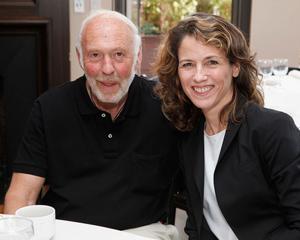Edward Thorp Biography
- Edward Thorp Biography Books
- Edward Thorp Biography Wikipedia
- Edward Thorp Biography Death
- Edward Thorp Biography Book
| Born | August 14, 1932 (age 88) Chicago, Illinois, U.S. |
|---|---|
| Citizenship | American |
| Alma mater | University of California, Los Angeles |
| Scientific career | |
| Fields | Probability theory, Linear operators |
| Institutions | UC Irvine, New Mexico State University, MIT |
| Thesis | Compact Linear Operators in Normed Spaces(1958) |
| Doctoral advisor | Angus E. Taylor |
| Influences | Claude Shannon |
Edward Oakley Thorp (born August 14, 1932) is an American mathematics professor, author, hedge fund manager, and blackjack researcher. He pioneered the modern applications of probability theory, including the harnessing of very small correlations for reliable financial gain.
Thorp is the author of Beat the Dealer, which mathematically proved that the house advantage in blackjack could be overcome by card counting.[1] He also developed and applied effective hedge fund techniques in the financial markets, and collaborated with Claude Shannon in creating the first wearable computer.[2]
Thorp received his Ph.D. in mathematics from the University of California, Los Angeles in 1958, and worked at the Massachusetts Institute of Technology (MIT) from 1959 to 1961. He was a professor of mathematics from 1961 to 1965 at New Mexico State University, and then joined the University of California, Irvine where he was a professor of mathematics from 1965 to 1977 and a professor of mathematics and finance from 1977 to 1982.[3]

Edward Oakley Thorp (born August 14, 1932) is an American mathematics professor, author, hedge fund manager, and blackjack researcher. He pioneered the modern applications of probability theory, including the harnessing of very small correlations for reliable financial gain. Thorp is the author. Quite the same Wikipedia.
Computer-aided research in blackjack[edit]
Thorp used the IBM 704 as a research tool in order to investigate the probabilities of winning while developing his blackjack game theory, which was based on the Kelly criterion, which he learned about from the 1956 paper by Kelly.[4][5][6][7] He learned Fortran in order to program the equations needed for his theoretical research model on the probabilities of winning at blackjack. Thorp analyzed the game of blackjack to a great extent this way, while devising card counting schemes with the aid of the IBM 704 in order to improve his odds,[8] especially near the end of a card deck that is not being reshuffled after every deal.
Applied research in Reno, Lake Tahoe and Las Vegas[edit]
Thorp decided to test his theory in practice in Reno, Lake Tahoe, and Las Vegas.[6][8][9]Thorp started his applied research using $10,000, with Manny Kimmel, a wealthy professional gambler and former bookmaker,[10] providing the venture capital. First they visited Reno and Lake Tahoe establishments where they tested Thorp's theory at the local blackjack tables.[9] The experimental results proved successful and his theory was verified since he won $11,000 in a single weekend.[6] Casinos now shuffle well before the end of the deck as a countermeasure to his methods. During his Las Vegas casino visits Thorp frequently used disguises such as wraparound glasses and false beards.[9] In addition to the blackjack activities, Thorp had assembled a baccarat team which was also winning.[9]
News quickly spread throughout the gambling community, which was eager for new methods of winning, while Thorp became an instant celebrity among blackjack aficionados. Due to the great demand generated about disseminating his research results to a wider gambling audience, he wrote the book Beat the Dealer in 1966, widely considered the original guide to card counting,[11] which sold over 700,000 copies, a huge number for a specialty title which earned it a place in the New York Times bestseller list, much to the chagrin of Kimmel whose identity was thinly disguised in the book as Mr. X.[6]
Thorp's blackjack research[12] is one of the very few examples where results from such research reached the public directly, completely bypassing the usual academic peer review process cycle. He has also stated that he considered the whole experiment an academic exercise.[6]

In addition, Thorp, while a professor of mathematics at MIT, met Claude Shannon, and took him and his wife Betty Shannon as partners on weekend forays to Las Vegas to play roulette and blackjack, at which Thorp was very successful.[13] His team's roulette play was the first instance of using a wearable computer in a casino — something which is now illegal, as of May 30, 1985, when the Nevada devices law came into effect as an emergency measure targeting blackjack and roulette devices.[2][13] The wearable computer was co-developed with Claude Shannon between 1960–61. The final operating version of the device was tested in Shannon's home lab at his basement in June 1961.[2] Based on his achievements, Thorp was an inaugural member of the Blackjack Hall of Fame.[14]
Edward Thorp Biography Books

He also devised the 'Thorp count', a method for calculating the likelihood of winning in certain endgame positions in backgammon.[15]
Stock market[edit]
Since the late 1960s, Thorp has used his knowledge of probability and statistics in the stock market by discovering and exploiting a number of pricing anomalies in the securities markets, and he has made a significant fortune.[5] Thorp's first hedge fund was Princeton/Newport Partners. He is currently the President of Edward O. Thorp & Associates, based in Newport Beach, California. In May 1998, Thorp reported that his personal investments yielded an annualized 20 percent rate of return averaged over 28.5 years.[16]
Bibliography[edit]
- (Autobiography) Edward O. Thorp, A Man for All Markets: From Las Vegas to Wall Street, How I Beat the Dealer and the Market, 2017. [1]
- Edward O. Thorp, Elementary Probability, 1977, ISBN0-88275-389-4
- Edward Thorp, Beat the Dealer: A Winning Strategy for the Game of Twenty-One, ISBN0-394-70310-3
- Edward O. Thorp, Sheen T. Kassouf, Beat the Market: A Scientific Stock Market System, 1967, ISBN0-394-42439-5 (online pdf, retrieved 22 Nov 2017)
- Edward O. Thorp, The Mathematics of Gambling, 1984, ISBN0-89746-019-7 (online version part 1, part 2, part 3, part 4)
- Fortune's Formula: The Untold Story of the Scientific Betting System That Beat the Casinos and Wall Street by William Poundstone
- The Kelly Capital Growth Investment Criterion: Theory and Practice (World Scientific Handbook in Financial Economic Series), ISBN978-9814293495, February 10, 2011 by Leonard C. MacLean (Editor), Edward O. Thorp (Editor), William T. Ziemba (Editor)
See also[edit]
References[edit]
Edward Thorp Biography Wikipedia

- ^Peter A. Griffin (1979) The Theory of Blackjack, Huntington Press, ISBN978-0929712130
- ^ abcEdward O. Thorp. 'The Invention of the First Wearable Computer'(PDF). Edward O. Thorp & Associates. Retrieved April 26, 2010.
- ^'Founding professor of math donates personal, professional papers to UCI Libraries'. UCI News. UC Irvine. June 12, 2018.
- ^Understanding Fortune’s Formula by Edward O. Thorp Copyright 2007 Quote: 'My 1962 book Beat the Dealer explained the detailed theory and practice. The “optimal” way to bet in favorable situations was an important feature.In Beat the Dealer I called this, naturally enough, “The Kelly gambling system,” since I learned about it from the 1956 paper by John L. Kelly.'
- ^ abTHE KELLY CRITERION IN BLACKJACK, SPORTS BETTING, AND THE STOCK MARKET by Edward O. Thorp Paper presented at: The 10th International Conference on Gambling and Risk Taking Montreal, June 1997
- ^ abcdeDiscovery channel documentary series: Breaking Vegas, Episode: 'Professor Blackjack' with interviews by Ed and Vivian Thorp
- ^The Tech (MIT) 'Thorpe, 704 Beat Blackjack' Vol. 81 No. I Cambridge, Mass., Friday, February 10, 1961
- ^ ab'American Scientist online: Bettor Math, article and book review by Elwyn Berlekamp'. Archived from the original on April 23, 2007. Retrieved March 18, 2006.CS1 maint: bot: original URL status unknown (link)
- ^ abcdIt's Bye! Bye! Blackjack Edward Thorp, the pensive professor above, is shaking the gambling world with a system for beating a great card game. He published it a year ago, and now the proof is in: it works David E. Scherman January 13, 1964 pp. 1–3 from SI Vault (beta)(CNN) Quotes: 'The unlikely trio was soon on its way to Reno and Lake Tahoe, where Thorp's horn-rimmed glasses, dark hair and fresh, scrubbed face hardly struck terror into the pit bosses. (p. 1)', 'But Edward Thorp and his computer are not done with Nevada yet. The classiest gambling game of all—just ask James Bond—is that enticing thing called baccarat, or chemin de fer. Its rules prevent a fast shuffle, and there is very little opportunity for hanky-panky. Thorp has now come up with a system to beat it, and the system seems to work. He has a baccarat team, and it is over $5,000 ahead. It has also been spotted and barred from play in two casinos. Could it be bye-bye to baccarat, too? (p. 1)' and 'But disguises frequently work. Thorp himself now uses a combination of wraparound glasses and a beard to change his appearance on successive Las Vegas visits. (p. 3)'
- ^Breaking Vegas “Professor Blackjack.”Archived December 21, 2008, at the Wayback Machine Biography channel Rated: TVPG Running Time: 60 Minutes Quote: 'In 1961, lifelong gambler Manny Kimmel, a 'connected' New York businessman, read an article by MIT math professor Ed Thorp claiming that anyone could make a fortune at blackjack by using math theory to count cards. The mob-connected sharpie offered the young professor a deal: he would put up the money, if Thorp would put his theory to action and card-count their way to millions. From Thorp's initial research to the partnership's explosive effect on the blackjack landscape, this episode boasts fascinating facts about the game's history, colorful interviews (including with Thorp), and archival footage that evokes the timeless allure and excitement of the thriving casinos in the early `60s. '
- ^'Blackjack Hero profile'. Blackjackhero.com. Retrieved April 26, 2010.
- ^A favorable strategy for twenty-one. Proceedings of the National Academy of Sciences 47 (1961), 110-112
- ^ ab'Poundstone, William: Fortune's Formula : The Untold Story of the Scientific Betting System That Beat the Casinos and Wall Street'. Retrieved April 26, 2010.
- ^Anthony Curtis. 'Las Vegas Advisor on Ed Thorp'. Lasvegasadvisor.com. Retrieved April 26, 2010.
- ^Chuck Bower (January 23, 1997). 'Cube Handling in Races: Thorpe count'. bkgm.com. Backgammon Galore. Retrieved May 8, 2013.
- ^'Thorp's market activities'. Webhome.idirect.com. Archived from the original on October 31, 2005. Retrieved April 26, 2010.
Edward Thorp Biography Death
Sources[edit]
- Patterson, Scott D., The Quants: How a New Breed of Math Whizzes Conquered Wall Street and Nearly Destroyed It, Crown Business, 352 pages, 2010. ISBN0-307-45337-5 via Patterson and Thorp interview on Fresh Air, February 1, 2010, including excerpt 'Chapter 2: The Godfather: Ed Thorp'
External links[edit]
- Edward O. Thorp at the Mathematics Genealogy Project
Edward Thorp Biography Book
